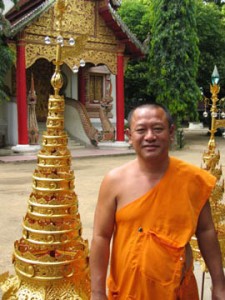There are over 120 wats within the municipal limits of the city of Chiang Mai, and they are the cultural — and to many degrees the social — hub of the city. They are held in such respect than there is a building ban on building any high-rise structure within 93 meters of a wat, to ensure a pleasing skyline, and an airy quality to life in the immediate vicinity. Many visitors spend a day or more walking to various temples, enjoying the architecture and ambiance. It’s easy to become quickly overwhelmed at their sheer numbers, so we’ve developed a quick list of the ones that are our favorites, and you can easily visit them all in less than a day, and on foot or bicycle.
When visiting a wat, please observe these protocols:
- Remove shoes when entering a wat
- Refrain from wearing sleeveless shirts and tops, or shorts
- Never point the soles of your feet to Buddha images
- Women are not allowed to touch monks. If presenting an object to a monk, women will either place it on the ground in front of the monk, and slightly to the side, or hand it to an attendant
- Buddha images are sources of reverence for Thais, so never take mocking photos, especially those that include you or your friends in the same frame as a Buddha image
Chiang Mai wats typically have three common structures, the viharn, or main meeting hall, the ubosot, a small, consecrated meeting hall for monks, and the chedi, a ceremonial stupa, in the shape of a rounded or faceted-sided pyramid. These structures may be gilded, adorned with glass mosaics and lacquer, and faced with teak, and beaten silver or aluminum. Women are not allowed into the ubosot.
We suggest visiting the following wats, which have compelling artistic merit:
Wat Phan Tao, Prapokkalo Road, between Ratchadamoen and Ratchamangkha roads. This extraordinarily beautiful wat is constructed of teak panels supported by 28 massive teak pillars, over a floor of lovely orange and green tiles. Above the entrance is a gable carving featuring a peacock above a sleeping dog. GPS: N18°47.262’ E098°59.280’
Wat Chedi Luang, Prapokkalo Road, between Ratchadamoen and Ratchamangkha roads. Immedistely to the south of Wat Phan Tao, you’ll find this wat, lying beneath the massive, 42 meter high Chedi Luang. The Chedi, which was originally 0ver 90 meters prior to the 1545 earthquake, is surrounded by a pictureaque most, and is guarded by a team of elephants. To the west of the chedi, you’ll find the stall of Pew Pattanasangcharee, who sells remarkable wall hangings stencil-cut from buffalo hide, and colorfully painted (GPS N18°47.230’ E098°59.169’). North of the chedi, you are invited to chat with monks informally, on any topic you wish. GPS: N18°47.221’ E098°59.276’
Wat Phra Singh, Singharat Road, south of Inthawarot Road. Located two blocks northwest of Wat Chedi Luang, this temple is particularly noted for the beautiful red and gold Viharn Lai Kham, located to the southwest of the main viharn. Lai Khma is a jewel of Lanna temple architecture, with intricately carved gables with elaborate gold tracery. GPS: N18°47.312’ E098°58.943’
Wat Chiang Man, Ratchaphakhinai Road, between Ratchaphakhinai Soi 1 and Prapokklao Soi 13. It’s well worth fighting off the touts and harassing tuk-tuk drivers inside the entrance of the wat to see the magnificent Chang Lom Chedi in the western side of the wat. Be especially careful of the slippery pavers as you gaze at the chedi surrounded by elephants and topped with gold, the oldest structure in the oldest wat (1297) in Chiang Mai. GPS: N18° 47.626’ E098°59.345’
Wat Bpa Bpao, Maninopharat Road. Situated just north of the northeast corner of the moat this is considered by many to be the finest Shan temple in Chiang Mai. The chedi, set in a beautiful sunken courtyard, is guarded by colorful dragons. GPS: N18°47.741’ E098°59.544’
Wat Phuak Taem, Samlan Soi 7, east of Sam Lan Road, near Bumrungburi Road, southwestern moat. While the façade to the viharn has very good design, the real draw to this wat is the onsite workshop, engaged in designing finials that adorn the top of stupas. GPS: N18°46.937’ E098°58.999’
Wat Sri Supan, Wualai Road, Soi 2. Located south of the southern moat, Wat Sri Supan has a beautiful beaten silver façade. Adjacent, near the entrance, is the workshop of Ajarn Manope Chaikaw, who makes exceptional aluminum respousée art, as well as aluminum architectural coverings for temple soffits. GPS: N18°46.727’ E098°59.012’
Wat Bupparam, Tha Phae Road, between Charoenprathet and Thaphae Soi 3. Here, the focal point is the small wooden Wat Meng, built in 1497. GPS: N18°47.291’ E098°58.885’

That is a great temple tip for northern Thailand.
Simple but very precise information… Many thanks for sharing this one.
A must read article!